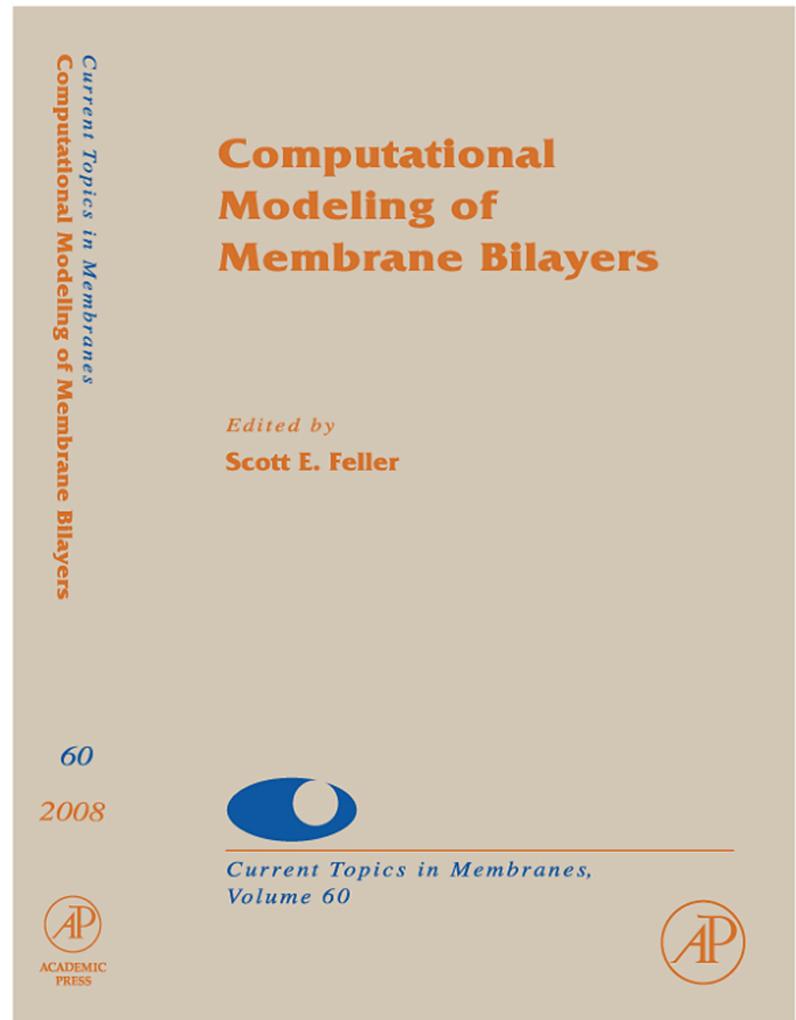Current Topics in Membranes provides a systematic, comprehensive, and rigorous approach to specific topics relevant to the study of cellular membranes. Each volume is a guest edited compendium of membrane biology.
- Discusses the current state of electrostatics in biomolecular simulations and future directions
- Includes information on time and length scales in lipid bilayer simulations
- Includes a chapter on the nature of lipid rafts
Inhaltsverzeichnis
1;Cover;1 2;Computational Modeling of Membrane Bilayers;4 3;Copyright page;5 4;Contents;6 5;Contributors;12 6;Preface;18 7;Previous Volumes in Series;24 8;Chapter 1. Considerations for Lipid Force Field Development;28 8.1;I. Introduction;29 8.2;II. Quantum Mechanics and Molecular Dynamics Based Parameter Optimization;31 8.3;III. Membrane Targets and Related Issues;47 8.4;IV. Summary and Perspectives;66 8.5;References;69 9;Chapter 2. Electrostatics in Biomolecular Simulations: Where Are We Now and Where Are We Heading?;76 9.1;I. Introduction;77 9.2;II. Importance of Long-Range Interactions in Simulations of Biological Systems;78 9.3;III. Overview of Methods and Their Applicability;79 9.4;IV. Non-Periodic Systems and Different Boundary Conditions;96 9.5;V. Applications and Latest Methodological Developments;98 9.6;VI. Final Notes on Software, Accuracy, and Speed;107 9.7;References;108 10;Chapter 3. Time and Length Scales in Lipid Bilayer Simulations;118 10.1;I. Introduction;118 10.2;II. Area per Lipid and Finite Size Effects;121 10.3;III. Undulations;123 10.4;IV. Peristaltic Fluctuations;128 10.5;V. Hydrocarbon Chain Dynamics;131 10.6;VI. Lateral Diffusion of Lipids;132 10.7;References;134 11;Chapter 4. Molecular Dynamics Simulation of Lipid-Protein Interactions;138 11.1;I. Introduction;139 11.2;II. Force Fields;141 11.3;III. Combining Force Fields;144 11.4;IV. Sampling Concerns;150 11.5;V. Validation of Lipid-Protein Simulations;152 11.6;VI. Conclusion and Perspective;154 11.7;References;155 12;Chapter 5. Implicit Modeling of Membranes;158 12.1;I. Introduction;158 12.2;II. Classes of Models;160 12.3;III. Interesting Problems in Implicit Membrane Modeling;173 12.4;IV. Conclusion;177 12.5;References;177 13;Chapter 6. Blue Matter: Scaling of N-Body Simulations to One Atom per Node;186 13.1;I. Introduction;187 13.2;II. Background on Massively Parallel Biomolecular Simulation;189 13.3;III. Inherent Concurrency of Molecular Dynamics;191 13.4;IV. Parallel Decompositions;194
13.5;V. Results;198 13.6;VI. Summary and Conclusions;203 13.7;References;205 14;Chapter 7. Multiscale Simulation of Membranes and Membrane Proteins: Connecting Molecular Interactions to Mesoscopic Behavior;208 14.1;I. Multiscale Aspects of Membrane Simulation: A Brief Review;209 14.2;II. New Multiscale Methods for Membrane Simulations;214 14.3;III. Selected Applications;228 14.4;IV. Summary;246 14.5;References;246 15;Chapter 8. Interactions between Small Molecules and Lipid Bilayers;254 15.1;Abbreviations;255 15.2;I. Introduction;255 15.3;II. Partitioning of Small Molecules in Lipid Bilayers;259 15.4;III. Conclusions;279 15.5;References;280 16;Chapter 9. On the Nature of Lipid Rafts: Insights from Molecularly Detailed Simulations of Model Biological Membranes Containing Mixtures of Cholesterol and Phospholipids;284 16.1;I. Introduction;284 16.2;II. Simulations;289 16.3;III. Concluding Remarks;302 16.4;References;303 17;Chapter 10. Atomistic and Mean Field Simulations of Lateral Organization in Membranes;308 17.1;I. Introduction;308 17.2;II. Molecular Dynamics Simulation of Hydrated Lipid Bilayers;311 17.3;III. General Issues in Force Feld Development for Biomolecular Simulations;312 17.4;IV. Simulation of Heterogeneous Lipid membranes;320 17.5;V. Application: A Mean Field Based Lipid Bilayer Model Based on MDSimulations;327 17.6;VI. Summary;335 17.7;References;336 18;Chapter 11. Molecular Modeling of the Structural Properties and Formation of High-Density Lipoprotein Particles;340 18.1;I. Introduction;340 18.2;II. Methods;345 18.3;III. Structure of Discoidal HDL;349 18.4;IV. Formation of Discoidal HDL;354 18.5;V. Conclusions;363 18.6;References;364 19;Chapter 12. Gas Conduction of Lipid Bilayers and Membrane Channels;370 19.1;I. Introduction;371 19.2;II. Computational Methodology;373 19.3;III. Lipid-Mediated Gas Conduction;375 19.4;IV. Protein-Mediated Gas Conduction;382 19.5;V. Concluding Remarks;389 19.6;References;390 20;Chapter 13. A Brief Introduction to Volta
ge-Gated K+ Channels;396 20.1;I. Introduction;396 20.2;II. Structure of Kv Channels and Gating Mechanisms;397 20.3;III. Free Energy and Membrane Voltage;406 20.4;IV. Conclusion;409 20.5;References;410 21;Chapter 14. Computational Models for Electrified Interfaces;412 21.1;I. Introduction;412 21.2;II. General Concepts of Surface Charge and Co/Counter Ions;413 21.3;III. Continuum Models;414 21.4;IV. Bridging from the Continuum to Molecular Calculations;416 21.5;V. All-Atom Models;420 21.6;VI. Long-Term Trends;424 21.7;VII. Summary;427 21.8;References;427 22;Chapter 15. Charged Protein Side Chain Movement in Lipid Bilayers Explored with Free Energy Simulation;432 22.1;I. Introduction;433 22.2;II. Theoretical Perspectives;436 22.3;III. Experimental Hydrophobicity and Membrane Partitioning Models;438 22.4;IV. Fully Atomistic Computer Simulations;442 22.5;V. Reconciling Simulation and Experiment;468 22.6;VI. Conclusion and Implications;475 22.7;References;480 23;Index;488





























